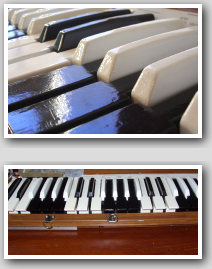
|
|
|
|
Why have the Balanced keyboard?
The standard musical keyboard has been with us for hundreds of years
and is the overwhelmingly ubiquitous and entrenched standard. However,
it does suffer from one major drawback, which is that its key layout is
not completely regular and consistent, specifically its pattern of 2 and
3 black notes in the top row.
This one shortcoming gives rise to a very
substantial level of complexity when it comes to being able to learn and
play musical structure on the standard keyboard. The term "musical
structure" used here refers to the chords, scales, intervals,
melodies, and all other elements of musical structure, as well as the
musical interrelationships between the elements.
The learning of musical structure on any
keyboard (and many other musical instruments) takes place largely in
terms of how the various musical structural elements are physically
'layed out' onto the keys of the keyboard. So, for a basic triad chord
consisting of 3 notes, the keys corresponding to the notes in the chord
will have a particular physical 'shape', which will be a basic mechanism
by which a player plays and recognises it.
The inconsistency of shape on the standard keyboard
On the standard keyboard, the inconsistent physical layout means that
there are many different shapes for each of the chords, scales and so
forth, depending on where on the keyboard they are played. For a simple
example of this, the following diagram shows the playing of a major
triad chord at different places on a standard keyboard. Each different
colour shows our major triad (with its consistent 'musical' shape)
starting at a different place on the keyboard.
Major
triads on the standard keyboard
(bottom- and top-row roots) |
|
|
|
|
Musically, a major triad has a consistent musical shape
in that its 3 component notes always have a fixed pitch relationship to
each other, namely a minor third on top of a major third. However, on a
standard keyboard, the major triad does NOT have a consistent physical
shape. Instead, the physical shape of the chord is different depending
on which root note the chord is played on. In fact, on the standard
keyboard, there are a total of six different shapes!
This inconsistency of physical shape in different keys is a basic
characteristic of playing musical structure on the standard keyboard.
For example, playing a major scale on a standard keyboard results in
many different shapes, depending on which of the 12 scale notes the
scale begins on.
The steep learning curve of the standard keyboard
On a standard keyboard, the rote-learning of the large numbers of
inconsistent physical shapes corresponding to each musical shape (for
example, 12 different scale layouts for each type of scale being
learned, e.g. major scale, harmonic minor scale etc) forms a
fundamental, and extremely tedious, part of learning to play the
standard keyboard. This constitutes a steep learning curve and
frustrating barrier to attaining a reasonable level of keyboard fluency.
So, if you want to learn to play the standard keyboard, there is a very
steep learning curve to gain even basic proficiency when it comes to
navigating your way around the keyboard in terms of musical structure.
For an idea of the myriad complexities of musical structure on the
standard keyboard, the excellent website
http://www.telacommunications.com/nutshell/
shows reference tables of chords and scales in each of the 12 keys on
the standard keyboard. As with all guides of this types, these are all
shown separately because there is little readily percievable consistency
around which the myriad of elements can be organised.
The Balanced keyboard alternative
The basic problems of the standard keyboard as outlined above have led
to various alternative keyboard designs over the years - see the
Other designs section of this website. However, none have become a
mainstream alternative to the standard keyboard. As well as the reason
that they are non-standard in layout, feel and playability, and
consequently people are wary of investing the time necessary to master
them, they are also not readily available. The Balanced keyboard, on the
other hand, has a similar layout, feel and playability to the standard
keyboard, and is readily available - you can construct a Balanced
keyboard by modifying a standard keyboard.
|
|